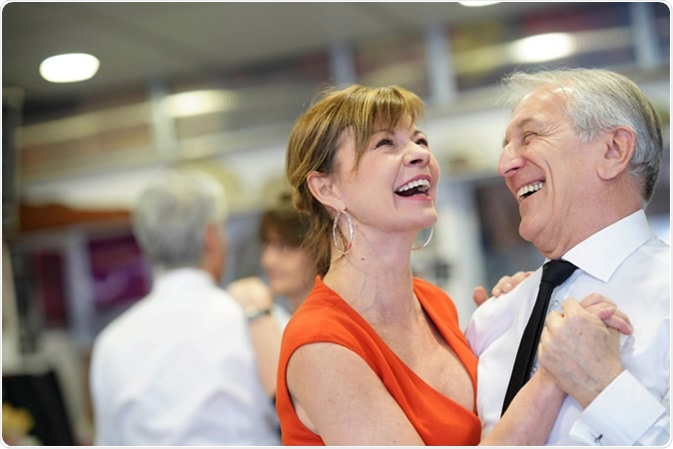
Is Dancing Good for the Brain?
Dance is a form of performing art wherein the body moves in a rhythmic way, usually to express feelings or ideas. Dancing has shown many health benefits, including boosting brain power and function.

Dancing can provide various physical benefits. Image Credit: goodluz / Shutterstock
What benefits does dancing have for the brain?
Dancing reduces depression symptoms
Dancing can provide various physical benefits but now, researches show promising results that it can also benefit the mind, with a growing body of evidence that suggests that dancing is good for mental health.
Depression is a disabling mental illness as evidenced by feelings of sadness, problems with emotion regulation, and loss of interest or pleasure in normally enjoyable activities. Depression affects more than 350 million people worldwide. Today, the most common and effective treatment for depression is medication in combination with counseling and psychotherapy.
In a study, the researchers examined whether dancing was a good treatment therapy for depression. Dancing focuses on body movement and emotional expression, that helps alleviate the symptoms of depression. At the same time, it helps reduce the levels of depression as shown by psychometric measures.
Dancing supports motor, emotional, and intellectual brain functions
Dance/Movement Therapy (DMT), also called movement psychotherapy, is the psychotherapeutic use of body movements to maintain and improve intellectual, motor, and emotional abilities of the body.
DMT is based on the conception that movement is a language, movement can be communicative and expressive, movement can be both an assessment tool and a primary mode of intervention, and the mind, body, and spirit are interconnected. Furthermore, dance movement therapists can look at a person’s movements to assess and intervene, thus enabling it to contribute to the treatment of mental health problems.
DMT has also been found to have a positive effect on children’s cognitive development. Dance can use spirituality, intelligence, spontaneity, and discovery while the body is producing movements, which is a form of art. Dance therapy can create a good environment for cognitive development.
Dance boosts memory
Dancing improves brain function and boosts memory. Several studies have shown that dancing is linked to a reduced risk of dementia. In a study by researchers at the Albert Einstein College of Medicine, they found that dancing is associated with 76% reduced risk of dementia among the participants.
Another study published on the Frontiers in Aging Neuroscience shows that dancing improves cerebral health. Dancing improves one of the cognitive domains, which is spatial memory.
The study also suggests that maintaining an active lifestyle into old age can preserve motor, cognitive, and perceptual abilities.
Dancing stimulates nerve growth factors
Dancing has many positive effects on the brain. The driving force behind its inhibition of aging relates to its ability to stimulate nerve growth factors. Nerve growth factors are proteins important for maintaining sensory neuron health.
In a study published in the Journal of Neuroscience & Biobehavioral Reviews, the researchers concluded that dancing can boost the connectivity between both cerebral hemispheres, and long-term dance practice positively affects brain activity. All these are linked to neuroplasticity, the brain’s ability to form new neural connections to change and adapt.
The combination of exercise and sensory enrichment during a dance can improve neuroplasticity. Hence, dancing can be used as an intervention for many neurological diseases, like stroke, Parkinson’s disease, and cerebral palsy.
Sources
- Punkanen, M., et al., (2017). Emotions in motion: depression in dance-movement and dance-movement in treatment of depression. Oxford Handbooks Online. DOI: 10.1093/oxfordhb/9780199949298.013.58
- Goodill, S. (2016). Dance/movement therapy and the arts in healthcare: the first 50 years. American Journal of Dance Therapy. https://dx.doi.org/10.1007%2Fs10465-016-9235-z Balgaonkar, AV. (2010). Effect of dance/ motor therapy on the cognitive development of children. International Journal of Arts and Sciences. www.openaccesslibrary.org/images/XEW191_Asmita_Vilas_Balgaonkar.pdf
- Verghese, J. et al., (2003). Leisure activities and the risk of dementia in the elderly. New England Journal of Medicine. DOI: 10.1056/NEJMoa022252
- Merom, D. et al., (2016). Cognitive benefits of social dancing and walking in old age: the dancing mind randomized controlled trial. Frontiers in Aging Neuroscience. https://doi.org/10.3389/fnagi.2016.00026
- Machado L. T. et al.,(2018). Dance for neuroplasticity: A descriptive systematic review. Neuroscience & Biobehavioral Reviews. https://doi.org/10.1016/j.neubiorev.2018.12.010
Further Reading
Last Updated: Jun 26, 2019






















.jpg)










No hay comentarios:
Publicar un comentario